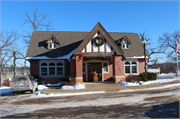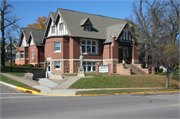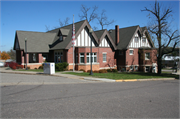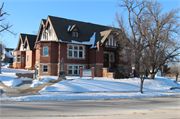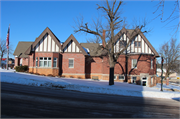Property Record
501 2nd Main St
Architecture and History Inventory
| Historic Name: | Elroy Public Library |
|---|---|
| Other Name: | Elroy Public Library |
| Contributing: | |
| Reference Number: | 112071 |
| Location (Address): | 501 2nd Main St |
|---|---|
| County: | Juneau |
| City: | Elroy |
| Township/Village: | |
| Unincorporated Community: | |
| Town: | |
| Range: | |
| Direction: | |
| Section: | |
| Quarter Section: | |
| Quarter/Quarter Section: |
| Year Built: | 1907 |
|---|---|
| Additions: | 2001 |
| Survey Date: | 199920142011 |
| Historic Use: | library |
| Architectural Style: | English Revival Styles |
| Structural System: | |
| Wall Material: | Brick |
| Architect: | Parkinson and Dockendorff [a]; H.m. Gordon |
| Other Buildings On Site: | |
| Demolished?: | No |
| Demolished Date: |
| National/State Register Listing Name: | Not listed |
|---|---|
| National Register Listing Date: | |
| State Register Listing Date: |
| Additional Information: | A 'site file' exists for this property. It contains additional information such as correspondence, newspaper clippings, or historical information. It is a public record and may be viewed in person at the Wisconsin Historical Society, Division of Historic Preservation. The Elroy Public Library was built in 1907 and designed by La Crosse architects Parkinson and Dockendorff. Elroy received a grant in the amount of $10,000 from Andrew Carnegie in 1906. The library opened on March 4, 1908. The building has housed the public library for more than 90 years. In 1998, the property to the rear was purchased for an addition that will be constructed in 2000. This addition will connect to the west (rear) wall of the library and will be compatible, if built as proposed. The Elroy Public Library is a fine and intact example of a Tudor Revival library building and retains excellent integrity. The statue is in memory of the American soldiers of the Civil War, Spanish American War, and World War I. Resurveyed December 2011; rear addition completed 2001. 2014- "The Elroy Public Library is located at 501 2nd Main Street/WIS 80 in the city of Elroy, in an area where the city's downtown transitions into a residential neighborhood. Sited on a slope, the front facade faces east onto 2nd Main Street. A concrete walkway and stairs on the front (east) facade provide access to a central gabled entry portico. Signs supported by small brick pillars flank the entrance stairs. A second set of stairs, constructed at or around the same time as the library, originally led to the sidewalk below. These were removed in the 1960s or 1970s when the present retaining wall was added. The property also contains a stone monument to Civil War, Spanish-American War, and World War I soldiers at the southeast corner, adjacent to the stairs. Depicting a World War 1-era infantryman, the statue (AHI #229724) was erected in 1924. Built in 1907, the library was designed by the La Crosse firm Parkinson and Dockendorff and construction was funded by a grant from Andrew Carnegie. The one-and-one-half-story Tudor Revival building is clad in brick and rests on a raised rusticated ashlar stone foundation with a stone water table. The steeply pitched side gable roof is covered with asphalt shingles and features simple verge boards and stucco with decorative half-timbering and paired multi-light casement windows in the gable ends. The eaves display exposed decorative rafter tails, and an interior brick chimney is located on the south (side) elevation. The central entrance on the front (east) facade is sheltered by a gable portico with decorative halftimbering and stucco in the gable above the inscription "Public Library." The roof is supported by brick buttresses with stone accents and the entrance consists of a pair of wood doors flanked by narrow, two-light, fixed windows. Windows on the front facade consist of groups of three pointed-arch fixed replacement sash with quoined stone surrounds and leaded-glass mullioned transoms. Two small dormers flank the entry portico and feature steeply pitched roofs and decorative half-timbering. The north and south (side) elevations have double-peaked gables with decorative half-timbering, and the south (side) elevation features two polygonal brick bays with double-hung windows. Remaining windows consist of double-hung sash in single, double, and triple configurations with mullioned upper sash or multi-paned transoms and stone sills. Windows in the dormers and gable ends are paired six-light casement sash. A secondary entrance to the basement level is located at the southeast corner of the south elevation within the east bay. The Library Board acquired adjacent lots to the rear of the original parcel in 1999 and constructed a sympathetic addition on the rear (west) elevation in 2001. Designed by River Architects, the 2001 addition has substantially increased the building footprint but is compatible in proportion, details, and materials. The rear elevation has a central gabled entry portico with brick posts and decorative half-timbering and stucco in the gable end. The addition is also executed in red brick with a random ashlar raised foundation, stone accents, and flattened pointed-arch windows. The north and south (side) elevations of the addition replicate the distinctive double-peaked, half-timbered gable ends of the original building. The main entrance on the front (east) facade opens onto a small foyer with stairs leading up to the first floor, accessed by a pair of glazed oak doors. A doorway on the north wall just inside the entrance leads to the stairs to the basement, while another doorway on the south wall of the upper landing opens onto a small storage/coat room. The main floor of the 1907 portion retains an open floor plan with a large reading area and the small librarian's office at the northwest corner now functions as the rare book room. A fireplace is located near the southwest corner. A drop-ceiling visible in 1999 survey photos has been removed and the high, coffered ceiling curves to meet the trim. The historic millwork remains, although fluorescent lighting has been added. The original oak shelving lines the perimeter walls, and two large oak benches flank the main doorway. Much of the historic furniture is still in use, including built-in periodical racks outside the librarian's office, a number of the original caned chairs and oak tables, and the central circulation desk. Freestanding shelves were added later, although these are also built of oak and match the original shelving. A wide doorway centered on the west wall opens onto the 2001 addition. Restrooms are located on the south side and the current librarian's office is located on the north side. The original circulation desk is now located in this central area. The architectural details in the addition match those in the historic portion, including curved ceilings, wood trim, and wall shelving. The basement level retains much of the original layout as well (see the accompanying floor plans). The stairs from the upper foyer lead to a small central hallway. A large open room occupies the majority of the south side of the building and retains its original fireplace at the southwest corner. This room was the men's reading room until 1938, when it became office space for City Hall. The entrance to the basement level is located in the bay on the south wall, accessed via a small foyer. Originally this foyer contained a short set of stairs separated from coat rooms on either side by partition walls. The basement was renovated in 2013 following flood damage; at that time, exterior site work lowered the grade by several feet and the stairs were removed to make the basement entrance handicapped-accessible. Although the coat hooks in the entryway remain, the dividing walls and doors to the coatrooms have been removed. The council room and other smaller rooms on the north side of the basement became the city clerk's offices in 1931 and were later used by the city's police department. The safe that was installed at some point during that period was removed in the 2013 renovation. The furnace room has also been removed, although the opening for the coal chute is still visible in what is now a utility space. The original restrooms were located on the east side of the building. The restroom accessed from the reading room has been converted into a kitchenette. The other restroom remains, accessed from the central hallway, and a second restroom has been created using a portion of a storage space beneath the entrance stairs. The addition does not have accessible basement spaces." -"Elroy Public Library", WisDOT# 5530-02-01, Prepared by Mead & Hunt, Inc., (2014). |
|---|---|
| Bibliographic References: | [A] "Library's Early History a Colorful Page in Local Saga," Elroy Leader-Tribune, March 3, 1988. |
| Wisconsin Architecture and History Inventory, State Historic Preservation Office, Wisconsin Historical Society, Madison, Wisconsin |

